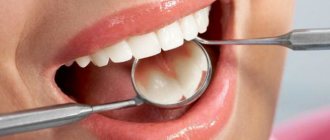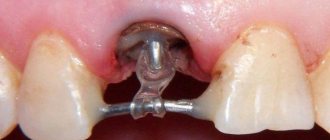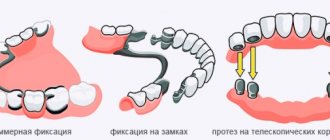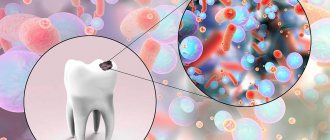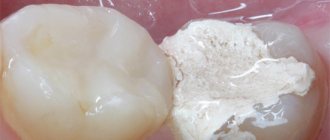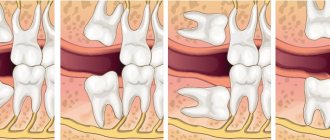If you have a toothache under a crown, do not panic - unpleasant sensations can occur immediately after a visit to the doctor and the installation of the structure itself.
Most likely, the pain will subside within 2-3 days. However, if a tooth begins to ache under a crown that was installed quite a long time ago, this is a reason to visit the doctor again. The possibilities of modern dentistry make it possible in most cases to save the tooth and the crown installed on it - the prognosis mainly depends on whether the “living” tooth hurts or whether it has already been depulped previously. There are several common reasons why a tooth hurts under a crown.
Causes of pain
As a rule, before installing a crown, the tooth is depulped - that is, the neurovascular bundle in the root and coronal part is removed, after which the canals are filled. Pain may be caused by some features of these manipulations:
- incomplete filling of the canals - as a result of the formation of voids in the root canals, an infectious process may begin to develop; Pus accumulates at the root tip, which causes pain. This is a common complication of endodontic treatment, especially in cases where the canals are too narrow or curved;
- subsidence of filling materials over time - even if the root canals are completely filled, changes in the physical properties of the materials can also lead to the appearance of voids - infection develops in them, inflammation spreads to the tissues near the apex of the tooth root;
- removal of the filling material beyond the root apex - “excess” material in the periodontal tissues can provoke irritation and inflammation.
Pulpitis. Inflammation of the pulp can occur in cases where a decision was made to preserve it - tooth processing can lead to a burn, the infectious process may already begin in the pulp and be asymptomatic, which becomes the cause of inflammation. Preserving living pulp before installing a crown on a tooth is a rare occurrence; as a rule, the “nerve” must be removed.
Perforation of the walls of the root canal. Perforation is the creation of a hole in the root canal, a phenomenon that occurs for several reasons:
- perforation may be a consequence of mechanical processing of the canal with a thin instrument - it must enter the canal along its entire length. If the canal is curved, then even a slight pressure can cause the instrument to pass through the tooth tissue;
- installation of a pin can lead to perforation - it is installed in the root canal, which, given the appropriate anatomical features of the structure of the root system, can also lead to the formation of a hole.
The hole is a “gateway” for infection—the tissue becomes inflamed some time after the pin is installed or endodontic treatment is performed, which causes pain.
Why does the tooth under the crown hurt?
The reason for this may be the presence of a foreign body in the canal. During endodontic treatment, the tip of the instrument may break off; subsequent filling of the canal with a foreign body leads to pain. There can be several reasons for breakage - the most common of them is the curvature of the canals. If they are difficult to pass, the tool may break due to the high load.
As a rule, in this case, the patient feels pain when exposed to temperatures, and the tooth under the crown also hurts when pressed. Pulsation may appear during exertion or chewing on the side with the crown installed. Tapping on a tooth also causes discomfort.
In order to avoid such a complication, the dentist must perform an x-ray diagnosis before installing a crown or any other dental prosthesis.
If the technology for processing and preparing the tooth for prosthetics is followed, installing a crown can also cause pain - if the design is too high for the bite, the patient feels discomfort when closing the jaws. This is why the stage of “trying on” the crown before its final installation is important - a good orthopedic dentist will first assess the degree of comfort for the patient.
Causes of toothache under a crown
- The main cause of toothache is considered to be improper implementation of a set of measures in preparation for prosthetics. During the preparation process, the dentist must remove the nerve near the root of the tooth and fill it. If the work is neglected, cases arise when the canal is not completely sealed. And even in the absence of nerve fibers, the pain remains. This often happens due to strongly curved roots.
- The second reason may be poor quality filling material. When subsidence occurs, the channel may become exposed, or cracks may occur. In this case, caries develops.
- Third, root canal perforation can also cause pain. When drilling a canal with a curved root, sometimes through drilling occurs. As a result, the infection enters from below, developing caries. Also, problems may arise when installing the pin, and the fit may not be sufficient. Again, infection occurs, etc. When drilling or expanding the canal, the dental device may break. As a result, it may remain inside. And then either the tooth is removed or filled with a foreign body.
Let's take a closer look at the causes of pain.
A pulpless tooth hurts
If the pulp has been removed, the pain is most often aching. It can radiate to the temple or ear. The main reason for this phenomenon is the exacerbation of chronic periodontitis. The choice of therapy method is determined by the presence or absence of a pin in the tooth root canal:
- there is no pin: the doctor opens the crown, unseals the root canals and treats them properly, after which he places materials impregnated with antibacterial agents into the tooth. Several changes to the medication may be required until complete relief is obtained and the inflammatory process is eliminated. After the symptoms have completely subsided, the canals are filled again and a new crown is installed;
- there is a pin: the doctor can cure periodontitis through surgery - resection of the apex of the tooth root. It is performed through a small incision in the gum, through which the source of infection is removed, and if necessary, the resulting void is filled with osteoplastic material. Typically, the intervention lasts from 30 to 60 minutes and is well tolerated by patients.
Clinical manifestations
Most often, patients note that the tooth under the crown hurts when pressed. Painful symptoms are especially evident when eating or when pressing on the prosthesis with the tongue. As inflammatory processes develop, pain symptoms become constant and do not require mechanical action for their manifestation. It can be bursting, aching or pulsating, often acute and intense. Depending on the neglect of the process and the reasons for its occurrence, pain is accompanied by the following clinical manifestations:
- Swelling of the gums or cheeks indicates inflammatory processes developing near the apex of the tooth root. As a rule, it appears on the gum in the projection of the affected root;
- A fistula opening on the gum tissue is formed due to lack of treatment after swelling of the gums. Pus flows through it, which forms at the apex of the tooth root;
- Cyst - develops during advanced inflammatory processes at the root tips. It is a cavity enclosed in fibrous tissue, which contains pus.
Any of the above symptoms is a reason to contact a dental clinic, where the patient will take an x-ray, make an accurate diagnosis and select the appropriate treatment.
Gum pain
If the gums hurt, and not the tooth itself with a crown installed, there may be a deformation of the crown or a discrepancy in its size - the gums are mechanically damaged, which leads to inflammation and pain. For example, the edge of the crown extends under the gum or, on the contrary, does not reach its edge significantly - in the first case, a sharp edge can lead to soft tissue injury and inflammation. Moreover, it is worth noting that the pain can radiate into the tooth itself, which makes self-diagnosis difficult - the patient simply does not understand that it is the gums that hurt, and not the tooth under the crown.
If the crown does not reach the edge of the gum, the tooth under the crown hurts greatly - but not immediately after installation, but after quite a long time. The retention of food debris between the edge of the structure and the gum leads to the proliferation of pathogenic bacteria, the development of caries, and the destruction of tooth tissue under the crown. This leads to severe pain, tooth reactions to temperature, stress, etc.
The doctor’s tactics in this case is to remove the unsuitable crown; this is the only measure that a specialist can take to eliminate the problem.
If the gums are swollen, and even more so in cases where there is swelling of the cheek, there is most likely inflammation in the area of the apex of the tooth root. As a rule, swelling forms in the projection of the apex of the root of the causative tooth. You cannot do without a visit to a dentist - he will decide on the choice of treatment method taking into account the condition, structural features of the dental system, and the severity of the disease.
A fistula on the gum often forms a certain time after the appearance of swelling. This happens because the pus accumulated at the apex of the root requires release - after its outflow is established, the symptoms may subside, but this does not mean that the disease has passed. In this case, a visit to the doctor is mandatory - it is important to treat the disease and prevent possible complications.
What should pregnant women do if they experience toothache under a crown?
It's no secret that during pregnancy a severe calcium deficiency occurs in the body. The teeth are the first to suffer from this. With proper nutrition, you can always replenish the calcium supply in a pregnant woman’s body. Alas, not all expectant mothers take care of themselves properly. It is not uncommon for pregnant women to visit the dentist.
If even the slightest toothache occurs, pregnant women are simply obliged to immediately consult a dentist. By the way, they are accepted everywhere out of turn. Know that any inflammation in the oral cavity, not to mention its purulent manifestation, necessarily affects the development of the fetus, and therefore the health of the newborn.
If it is not possible to quickly get to the dentist, pregnant women should at least slow down the further development of dental disease using traditional methods. To do this, you can rinse the mouth with soda, salt, chlorhexidine, chamomile or furatsilin. You can apply a piece of cotton wool soaked in a solution of dental drops to the area of pain. In particularly acute cases, you can take a paracetamol tablet. At the 5th month of pregnancy, you will already be able to withstand pain relief, so during this period, feel free to make an appointment with the dentist.
When is pain normal?
Even a perfectly installed crown can provoke painful sensations immediately after prosthetics - as the local anesthesia wears off. The pain may be constant or occur with pressure. How to distinguish these sensations from those caused by pathology?
Firstly, pain normally lasts no more than 1-3 days - this is due to the adaptation of tissues to the new structure in the oral cavity.
Secondly, the pain tends to subside. Increasing sensations indicate a pathological process.
Is it possible to carry out treatment without removing the crown?
In some cases, treatment eliminates the need to remove dentures. To do this, the dentist makes a hole in the crown itself, through which he carries out all the necessary procedures. After treatment is completed, the holes are filled, restoring the appearance of the crown.
If there is a pin and filling defects only in the upper third of the root canal, resection of the root apex is possible. The operation involves cutting off the apex from the root, removing pus and does not require much time. Its use eliminates the need to remove the crown and refill the canals, which will save money and time for the patient.
If you encounter problems after installing a crown, contact Good Hands Dentistry in Lyublino!
How to help yourself if the tooth under the crown hurts?
A tooth hurts under a crown - how to relieve the discomfort? It is important to make an appointment with a doctor first. Painkillers can be used as temporary measures, but you should consult with your doctor about the advisability of their use. It will not be possible to eliminate the cause of the pain at home - you can only alleviate the symptom a little.
You can resort to rinsing the mouth with warm water, in which 1 tsp was previously diluted. salt. A weak decoction of chamomile can also be used after first checking the temperature of the product - it should be room temperature.
Avoid heating the diseased tooth - hot compresses can lead to complications. Also, you should not apply “burning” products like garlic to the gums - you can get a burn to the mucous membrane.
How to dull the pain?
It happens that pain in a tooth strikes suddenly, and there is no way to see a dentist. In such cases, it is not uncommon for residents of remote settlements, sailors, geologists, people working on rotation in hard-to-reach regions, etc. Let's consider some methods for reducing pain. Note that the pain will disappear only for a while, so it is still worth contacting a specialist as soon as possible to eliminate the causes.
The first thing you can do in the field is to create a solution of soda, salt and iodine. Frequent rinsing with such a liquid will not only soothe the pain, but also have a disinfecting effect and stop inflammation. Decoctions of chamomile or sage also help against inflammatory processes.
The ancestors also used a head of garlic to soothe pain. By applying it to the sore gum, the pain could be dulled. Interesting fact: if you apply a cut clove of garlic to the vein on your wrist from the side of the tooth, the pain will also disappear over time.
How to prevent pain?
Prevention of toothache under a crown includes following your doctor’s recommendations: crowns should be brushed just like your own teeth - at least 2 times a day. It is worth paying special attention to cleaning the spaces between the teeth and around the gums - this is where the largest amount of food debris and plaque accumulates. It is recommended to use not only a toothbrush and toothpaste, but also dental floss and, if possible, an irrigator.
You will have to refrain from eating solid foods - seeds, nuts, in order to avoid damage to the crown.
Visit your dentist at least once a year to monitor the quality of your dentures.


